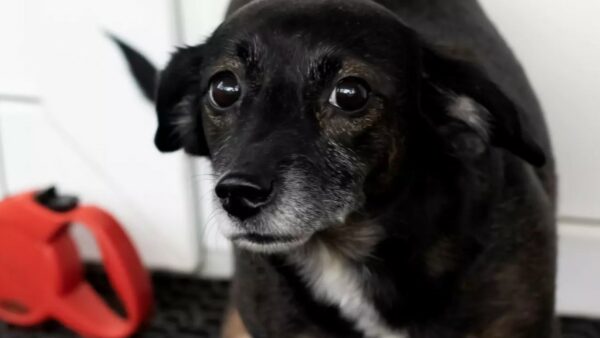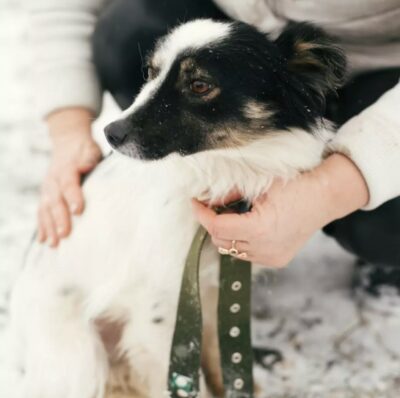How to help a dog that is scared?

WHAT WILL YOU READ IN THE TEXT:
How do you recognise anxiety in your dog?
Help your dog feel safe
Can I comfort a frightened dog?
Punishment does not help
Should I force my dog to face his fears?
Have a lot of patience
Did you know that studies have shown that as many as 72.5% of dogs show some form of anxiety?
Most dogs show signs of separation anxiety, while many others suffer from so-called noise phobias, of which fear of fireworks and poppers is the most common. However, there are also many other forms of anxiety and phobias. For example, your four-legged friend may be afraid of other people or dogs, and owners often struggle to recognise these fears.
Read on to discover 6 important things you need to know if you have a shy or anxious dog.
1. Learn to recognise your dog's fear
3. Comfort your dog
 You have probably often heard that you should not comfort your dog when he is scared.
You have probably often heard that you should not comfort your dog when he is scared.
Well, we have good news: it is totally okay to comfort a frightened dog, especially if your dog comes to you for comfort on his own.
Unfortunately, even among well-known dog trainers, there are proponents of the theory that you should not comfort dogs because this would supposedly "approve" their fear. This theory is a myth, which means you can feel free to comfort your dog when he is scared. Indeed, you are his safe haven, and support from his favourite person can help your beloved four-legged friend immensely in stressful situations.
Some dogs prefer to be alone when they are stressed, and that is totally okay too. If your dog withdraws voluntarily, don't force it.
4. Never punish your dog
In general, punishing your pet in any way can be very detrimental to its mental and physical health. But when it comes to timid and anxious dogs, it is particularly important to use a positive approach and not punish. Punishment can worsen your dog's anxiety, and it is even very likely that over time, your dog will start to fear you too.
Your pet is already under great stress and afraid of whatever the source of his fear is. Don't increase his stress by punishing or shouting. Maybe the fears don't seem realistic to you, and maybe you even find them funny. But the important thing is this: in your dog's eyes, those fears are very real.
5. Don't force your dog to "confront" his fears
Another popular myth about dog behaviour is that you should put your dog in stressful situations so he can "adapt to it". Unfortunately, this is very bad advice.
Dogs should be exposed to their fears gradually, so that they can get used to them step by step and associate the fearful situation with something they like. These techniques are called desensitisation and counter-conditioning, and while they sound simpler than they are in practice, they can cause harm if not applied properly. Simply exposing the source of fear will cause more harm than benefit, and here's why.
What can happen if we force a timid dog to expose himself to stressful situations? First, your dog will probably become more anxious and try to escape the situation any way he can. 
What can also happen is that the dog becomes aggressive in an attempt to drive away what scares him - be it people or other dogs.
Some dogs may panic or completely shut themselves off from the situation. This leads to so-called learned helplessness - the dog realises there is no way out and completely closes in on itself.
Unfortunately, in these cases, it may seem as if the dog is no longer worried because he is no longer trying to escape. The problem, however, is that such dogs suffer tremendously mentally, which can lead to a host of new behavioural problems.
Remember, you are the person who should provide your pet with safety. Instead of pushing your dog into stressful situations, try to ease those situations for him.
6. Have a lot of patience
Sometimes it takes longer for your dog to overcome his fears and anxiety, and there are also more serious cases where dogs never completely get rid of their fears.
However, it is important to know that your dog can have a happy life, despite his fears, if you handle it in the right way. Believe me, even the smallest advances in timid dogs mean a lot. Arm yourself with patience and offer your dog support at all times.
Conclusion
The most important thing is always to support your beloved pet so that he can overcome his fears more easily. If you think your dog is not making progress or his fears are getting worse, do not hesitate to consult a behavioural therapist - just make sure it is a force-free therapist.
Also keep in mind that anxiety may have a cause in a more serious health problem, therefore it may be a good idea to visit a vet if the situation worsens.
In addition, consider giving your dog natural food supplements that help calm pets, such as Apipet Calma. Such supplements can greatly help your dog and can be used in the long run, as it is a natural product with no side effects.


